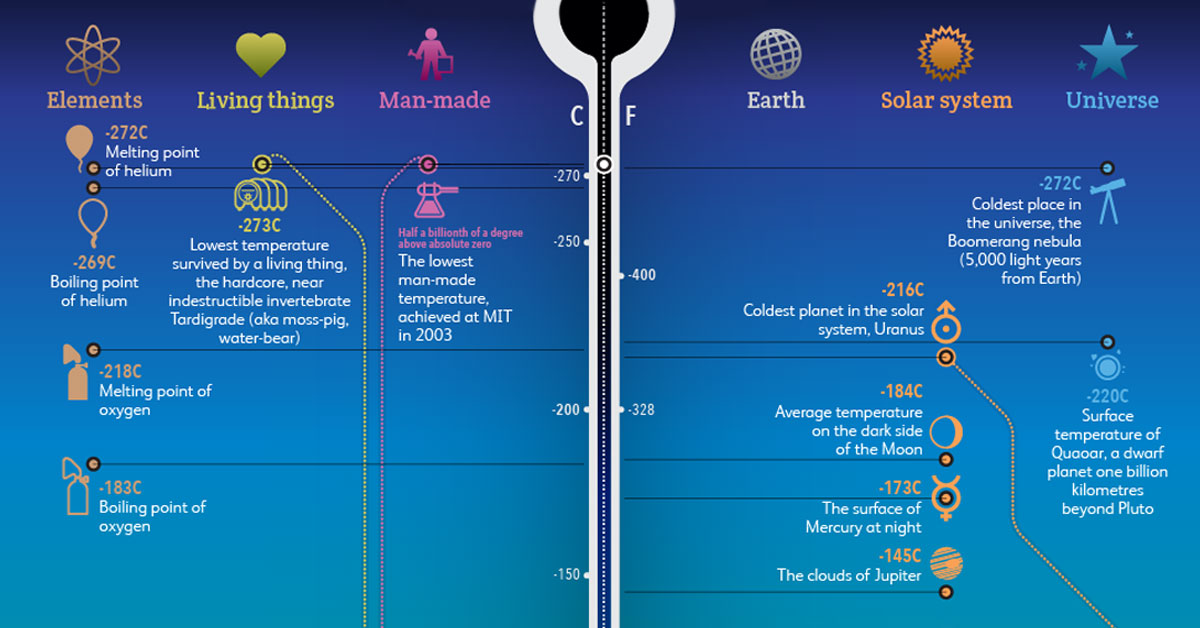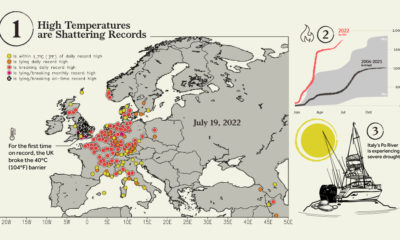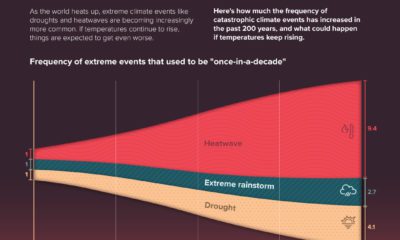Misc
The Extreme Temperatures of the Universe

The Extreme Temperatures of the Universe
For most of us, temperature is a very easy variable to overlook.
Our vehicles and indoor spaces are climate controlled, fridges keep our food consistently chilled, and with a small twist of the tap, we get water that’s the optimal temperature. Of course, our concept of what’s hot or cold is actually very narrow in the grand scheme of things.
Even the stark contrast between the wind-swept glaciers of Antarctica and the blistering sands of our deserts is a mere blip on the universe’s full temperature range. Today’s graphic, produced by the IIB Studio, looks at the hottest and coldest temperatures in our universe.
But First: What is Temperature Anyway?
Before looking at this top-to-bottom view of extreme temperatures, it helps to remember what temperature is actually measuring – kinetic energy, or the movement of atoms.
Hypothetically, atoms would simply stop moving as they reach absolute zero. As matter heats up, it begins to “vibrate” more vigorously, changing states from solid to gas. Eventually, plasma forms as electrons wander away from the nuclei.
With that quick primer, let’s dig into some of the hottest insights in this cool data visualization.
Highs and Lows on Planet Earth
Earth’s lowest air temperature, -135ºF (-93ºC), was recorded in Antarctica in 2010. Since then, scientists have discovered that surface ice temperatures can dip as low as -144ºF (-98ºC).
The conditions need to be just right: clear skies and dry air must persist for several days during the polar winter. In surroundings this cold, human lungs would actually hemorrhage within just a few breaths.
On the other end of the spectrum of extreme temperatures, the hottest surface reading on Earth of 160ºF (71ºC) occurred in Iran’s Lut Desert in 2005. In fact, the Lut Desert clocked the highest surface temperature in 5 out of 7 years during a 2003-2009 study, making it the world’s hottest location. The desert’s dark pebbles, dry soil, and lack of vegetation create the perfect conditions for blistering heat.
There are very few organisms that can withstand such temperatures, but one fascinating phylum makes the cut.
The Amazing Tardigrade
Commonly known as a “moss pig” or “water bear”, the one-millimeter long tardigrade is extremely resilient. While most organisms need water to survive, the tardigrade gets around this by entering a “tun” state, in which metabolism slows to just 0.01% of its normal rate.
When water is scarce, the creature curls up and synthesizes molecules that lock sensitive cell components in place until re-hydration occurs. Beyond dry conditions, the tardigrade can also survive both freezing and boiling temperatures, high radiation environments, and even the vacuum of space.
This video courtesy of TEDEd explains more about the hardy critter:
Testing the Limits
For better or worse, humans have pushed the limits of temperature here on Earth.
At MIT, scientists cooled a sodium gas to half-a-billionth of a degree above absolute zero. In the words of the Nobel Laureate Wolfgang Ketterle, who co-led the team: “To go below one nanokelvin (one-billionth of a degree) is a little like running a mile under four minutes for the first time.”
Not all experiments are conducted out of simple curiosity. Conventional bombs already explode at around 9,000ºF (5,000ºC), but nuclear explosions take things much further. For a split second, temperatures inside a nuclear fireball can reach a mind-bending 18,000,000ºF (10,000,000ºC).
The highest man-made temperature ever recorded is 9,900,000,000,000ºF (5,500,000,000,000ºC), created in the Large Hadron Collider at CERN in Switzerland. It was achieved by accelerating heavy lead ions to 99% the speed of light and smashing them together.
Highs and Lows of the Universe
While humans have been able to manufacture extremely hot and cold temperatures, the universe has created these extremes naturally.
Undoubtedly, the creation of the universe is made of the hottest stuff of all. The temperature of the universe at 10⁻³⁵ seconds old was a whopping 1 octillion ºC. Moments later, it “cooled down” to 1,800,000,000ºF (1 billion ºC) when the universe was less than two minutes old.
On the other end of the spectrum, the coolest natural place currently known in the universe is the Boomerang Nebula at -457.6ºF (-272ºC). It’s found 5,000 light years away from us in the constellation Centaurus, and it is currently in a transitional phase as a dying star.
As space exploration goes further than ever, these extreme temperatures may one day reach even hotter or colder heights than we can imagine.
Misc
How Hard Is It to Get Into an Ivy League School?
We detail the admission rates and average annual cost for Ivy League schools, as well as the median SAT scores required to be accepted.

How Hard Is It to Get Into an Ivy League School?
This was originally posted on our Voronoi app. Download the app for free on iOS or Android and discover incredible data-driven charts from a variety of trusted sources.
Ivy League institutions are renowned worldwide for their academic excellence and long-standing traditions. But how hard is it to get into one of the top universities in the U.S.?
In this graphic, we detail the admission rates and average annual cost for Ivy League schools, as well as the median SAT scores required to be accepted. The data comes from the National Center for Education Statistics and was compiled by 24/7 Wall St.
Note that “average annual cost” represents the net price a student pays after subtracting the average value of grants and/or scholarships received.
Harvard is the Most Selective
The SAT is a standardized test commonly used for college admissions in the United States. It’s taken by high school juniors and seniors to assess their readiness for college-level academic work.
When comparing SAT scores, Harvard and Dartmouth are among the most challenging universities to gain admission to. The median SAT scores for their students are 760 for reading and writing and 790 for math. Still, Harvard has half the admission rate (3.2%) compared to Dartmouth (6.4%).
| School | Admission rate (%) | SAT Score: Reading & Writing | SAT Score: Math | Avg Annual Cost* |
|---|---|---|---|---|
| Harvard University | 3.2 | 760 | 790 | $13,259 |
| Columbia University | 3.9 | 750 | 780 | $12,836 |
| Yale University | 4.6 | 760 | 780 | $16,341 |
| Brown University | 5.1 | 760 | 780 | $26,308 |
| Princeton University | 5.7 | 760 | 780 | $11,080 |
| Dartmouth College | 6.4 | 760 | 790 | $33,023 |
| University of Pennsylvania | 6.5 | 750 | 790 | $14,851 |
| Cornell University | 7.5 | 750 | 780 | $29,011 |
*Costs after receiving federal financial aid.
Additionally, Dartmouth has the highest average annual cost at $33,000. Princeton has the lowest at $11,100.
While student debt has surged in the United States in recent years, hitting $1.73 trillion in 2023, the worth of obtaining a degree from any of the schools listed surpasses mere academics. This is evidenced by the substantial incomes earned by former students.
Harvard grads, for example, have the highest average starting salary in the country, at $91,700.
-

 Real Estate2 weeks ago
Real Estate2 weeks agoVisualizing America’s Shortage of Affordable Homes
-

 Technology1 week ago
Technology1 week agoRanked: Semiconductor Companies by Industry Revenue Share
-

 Money1 week ago
Money1 week agoWhich States Have the Highest Minimum Wage in America?
-

 Real Estate1 week ago
Real Estate1 week agoRanked: The Most Valuable Housing Markets in America
-

 Business2 weeks ago
Business2 weeks agoCharted: Big Four Market Share by S&P 500 Audits
-

 AI2 weeks ago
AI2 weeks agoThe Stock Performance of U.S. Chipmakers So Far in 2024
-

 Misc2 weeks ago
Misc2 weeks agoAlmost Every EV Stock is Down After Q1 2024
-

 Money2 weeks ago
Money2 weeks agoWhere Does One U.S. Tax Dollar Go?














